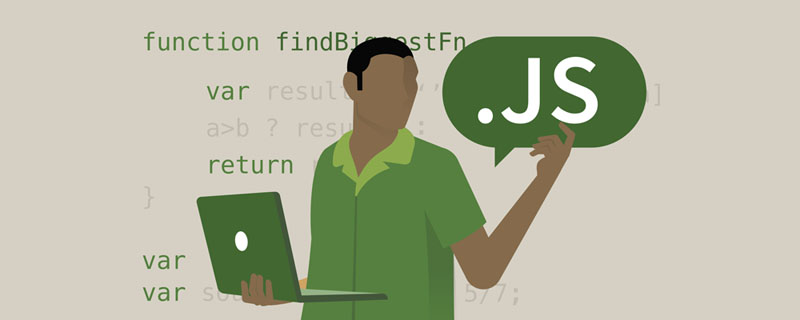Detailed introduction to JavaScript: three introduction methods
This article brings you relevant knowledge about javascript, which introduces in detail the three introduction methods of JavaScript: inline, embedded style, external style and how to use them; let’s take a look at them together ,I hope everyone has to help.

[Related recommendations: javascript video tutorial, web front-end】
1. Inside the industry The introduction method
is written in the line, and is set separately in each tag.
References the js function through the event attribute in the opening tag.
(1) is written in Among the event attributes of the tag (attributes starting with on), such as onclick [on event type]
Recommendation: use double quotes for html and single quotes for js
Example:
<input>
Note: Inline introduction, there is no concept of increasing weight in JS, so it is not commonly used [Basically not used]
##Example As follows:
<html>
<title>js样式内联写法</title>
<meta http-equiv="content-type" content="text/html; charset=utf-8" />
<body>
<!--js内联写法01开始-->
<!--当鼠标点击图片时跳出弹窗显示1223-->
<div class="img">
单击事件:
<img src="/static/imghw/default1.png" data-src="images/001.jpg" class="lazy" onclick="alert(1223)" alt="Detailed introduction to JavaScript: three introduction methods" ></img>
</div>
<!--js内联写法01结束-->
</body>
</html>
Write in script tag
Internal reference: By writing js code in script tag, use
- script tag can be written anywhere on the page
- script tag is usually used at the end of the body, or after the body
- (1) can be written anywhere;
When we need to reference the script on the head, put it on the head, otherwise it is placed on the bottom, because placing on the head may affect the browser rendering.
<script>
alert('Hello World!');
</script>Note: Usually when you write exercises by yourself, you use it when you want to be lazy and don’t want to set up js files [
Practice use]Usually do it yourself The project is placed at the bottom, which does not affect the loading order and can be distinguished from CSS files, and does not affect browser rendering; if placed elsewhere, it is best to use onload to wrap it up with
The example is as follows: <html>
<title>js样式内联写法</title>
<meta http-equiv="content-type" content="text/html; charset=utf-8" />
<body>
<!--js内联写法02开始-->
<div class="img">
单击事件:
<img src="/static/imghw/default1.png" data-src="images/002.jpg" class="lazy" id='yuansu' alt="Detailed introduction to JavaScript: three introduction methods" ></img>
</div>
<!--js内联写法02结束-->
</body>
<script>
//js代码
//找到XX元素,一般给元素加id
yuansuojb=document.getElementById('yuansu');
//给xx元素加事件
yuansuojb.onclick=function(){
//代码段
alert(1);
}
//触发事件
</script>
</html>

Use src in the script tag to introduce external files
Steps:
- Write an independent js file
- Referenced through the script tag in the page
- (1) No code can be written in the script that introduces the external JS file
( 2) Use HTML page code structure to separate multiple pieces of JS code outside the HTML page, which is beautiful and convenient for file reuse
<script src="main.js"></script>
Note: Like inline styles, placing them at the bottom and head needs to be considered on a case-by-case basis [
Frequently used] Use src instead of href
The example is as follows:
Write the js code into the .js file, and reference the
.html file content in the HTML as follows:
<html>
<title>js样式外联写法</title>
<meta http-equiv="content-type" content="text/html; charset=utf-8" />
<body>
<div class="img">
外联写法--单击事件:
<img src="/static/imghw/default1.png" data-src="images/003.jpg" class="lazy" id='yuansu' alt="Detailed introduction to JavaScript: three introduction methods" ></img>
</div>
</body>
<script src='js/index.js'></script>
</html>.js file content is as follows:
//js代码
//找到XX元素,一般给元素加id
yuansuojb=document.getElementById('yuansu');
//给xx元素加事件
yuansuojb.onclick=function(){
//代码段
var str="hello world !!!";
alert(str);
}Output result:
 [Related recommendations:
[Related recommendations:
The above is the detailed content of Detailed introduction to JavaScript: three introduction methods. For more information, please follow other related articles on the PHP Chinese website!

Hot AI Tools

Undresser.AI Undress
AI-powered app for creating realistic nude photos

AI Clothes Remover
Online AI tool for removing clothes from photos.

Undress AI Tool
Undress images for free

Clothoff.io
AI clothes remover

Video Face Swap
Swap faces in any video effortlessly with our completely free AI face swap tool!

Hot Article

Hot Tools

Notepad++7.3.1
Easy-to-use and free code editor

SublimeText3 Chinese version
Chinese version, very easy to use

Zend Studio 13.0.1
Powerful PHP integrated development environment

Dreamweaver CS6
Visual web development tools

SublimeText3 Mac version
God-level code editing software (SublimeText3)

Hot Topics
 1386
1386
 52
52
 How to implement an online speech recognition system using WebSocket and JavaScript
Dec 17, 2023 pm 02:54 PM
How to implement an online speech recognition system using WebSocket and JavaScript
Dec 17, 2023 pm 02:54 PM
How to use WebSocket and JavaScript to implement an online speech recognition system Introduction: With the continuous development of technology, speech recognition technology has become an important part of the field of artificial intelligence. The online speech recognition system based on WebSocket and JavaScript has the characteristics of low latency, real-time and cross-platform, and has become a widely used solution. This article will introduce how to use WebSocket and JavaScript to implement an online speech recognition system.
 WebSocket and JavaScript: key technologies for implementing real-time monitoring systems
Dec 17, 2023 pm 05:30 PM
WebSocket and JavaScript: key technologies for implementing real-time monitoring systems
Dec 17, 2023 pm 05:30 PM
WebSocket and JavaScript: Key technologies for realizing real-time monitoring systems Introduction: With the rapid development of Internet technology, real-time monitoring systems have been widely used in various fields. One of the key technologies to achieve real-time monitoring is the combination of WebSocket and JavaScript. This article will introduce the application of WebSocket and JavaScript in real-time monitoring systems, give code examples, and explain their implementation principles in detail. 1. WebSocket technology
 How to use JavaScript and WebSocket to implement a real-time online ordering system
Dec 17, 2023 pm 12:09 PM
How to use JavaScript and WebSocket to implement a real-time online ordering system
Dec 17, 2023 pm 12:09 PM
Introduction to how to use JavaScript and WebSocket to implement a real-time online ordering system: With the popularity of the Internet and the advancement of technology, more and more restaurants have begun to provide online ordering services. In order to implement a real-time online ordering system, we can use JavaScript and WebSocket technology. WebSocket is a full-duplex communication protocol based on the TCP protocol, which can realize real-time two-way communication between the client and the server. In the real-time online ordering system, when the user selects dishes and places an order
 How to implement an online reservation system using WebSocket and JavaScript
Dec 17, 2023 am 09:39 AM
How to implement an online reservation system using WebSocket and JavaScript
Dec 17, 2023 am 09:39 AM
How to use WebSocket and JavaScript to implement an online reservation system. In today's digital era, more and more businesses and services need to provide online reservation functions. It is crucial to implement an efficient and real-time online reservation system. This article will introduce how to use WebSocket and JavaScript to implement an online reservation system, and provide specific code examples. 1. What is WebSocket? WebSocket is a full-duplex method on a single TCP connection.
 JavaScript and WebSocket: Building an efficient real-time weather forecasting system
Dec 17, 2023 pm 05:13 PM
JavaScript and WebSocket: Building an efficient real-time weather forecasting system
Dec 17, 2023 pm 05:13 PM
JavaScript and WebSocket: Building an efficient real-time weather forecast system Introduction: Today, the accuracy of weather forecasts is of great significance to daily life and decision-making. As technology develops, we can provide more accurate and reliable weather forecasts by obtaining weather data in real time. In this article, we will learn how to use JavaScript and WebSocket technology to build an efficient real-time weather forecast system. This article will demonstrate the implementation process through specific code examples. We
 Simple JavaScript Tutorial: How to Get HTTP Status Code
Jan 05, 2024 pm 06:08 PM
Simple JavaScript Tutorial: How to Get HTTP Status Code
Jan 05, 2024 pm 06:08 PM
JavaScript tutorial: How to get HTTP status code, specific code examples are required. Preface: In web development, data interaction with the server is often involved. When communicating with the server, we often need to obtain the returned HTTP status code to determine whether the operation is successful, and perform corresponding processing based on different status codes. This article will teach you how to use JavaScript to obtain HTTP status codes and provide some practical code examples. Using XMLHttpRequest
 How to use insertBefore in javascript
Nov 24, 2023 am 11:56 AM
How to use insertBefore in javascript
Nov 24, 2023 am 11:56 AM
Usage: In JavaScript, the insertBefore() method is used to insert a new node in the DOM tree. This method requires two parameters: the new node to be inserted and the reference node (that is, the node where the new node will be inserted).
 JavaScript and WebSocket: Building an efficient real-time image processing system
Dec 17, 2023 am 08:41 AM
JavaScript and WebSocket: Building an efficient real-time image processing system
Dec 17, 2023 am 08:41 AM
JavaScript is a programming language widely used in web development, while WebSocket is a network protocol used for real-time communication. Combining the powerful functions of the two, we can create an efficient real-time image processing system. This article will introduce how to implement this system using JavaScript and WebSocket, and provide specific code examples. First, we need to clarify the requirements and goals of the real-time image processing system. Suppose we have a camera device that can collect real-time image data




